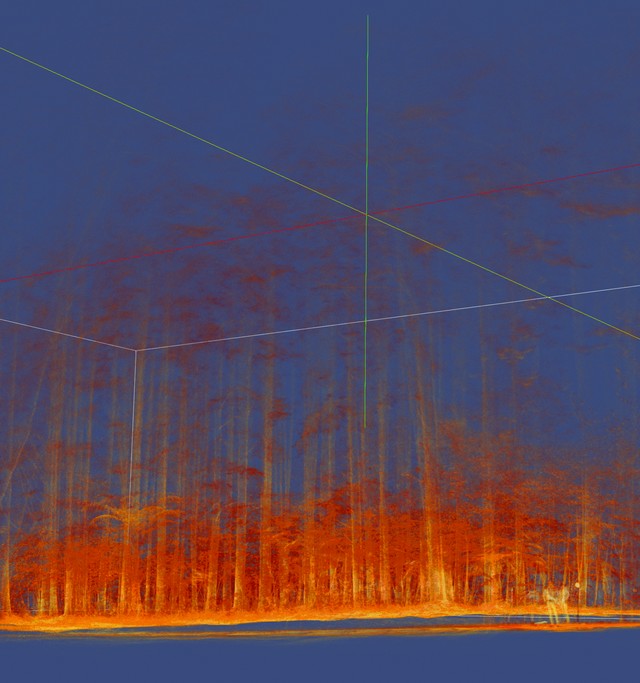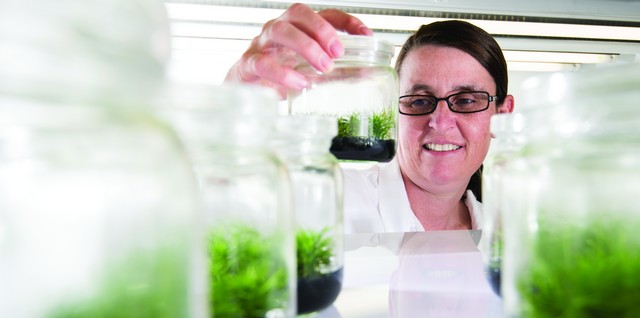Closing the gap on forest productivity

Genetics, environment and forest management or silviculture, all affect forest productivity and wood quality. Understanding the effect and interactions of these will help us close the gap between actual and potential productivity to create highly productive and profitable future forests.
The research programme Growing Confidence in Forestry’s Future (GCFF) is wrapping up this year after six years of research activity. One of the goals in this programme was to understand what drives forest productivity to meet New Zealand forest growers’ vision to double the production of planted forests.
Is there a productivity gap?
The main factors that affect forest productivity are climate, soil, genetics and silviculture. Identifying the current limiting factor allows forest managers to take steps to close the gap between actual and potential productivity. The first step is to work out what is going on in your forest through forest inventory and monitoring.
Remote sensing provides new insights into forest structure and condition
Scion’s Forest Informatics Team has developed lidar scanning techniques for forest inventory. While lidar is very precise, the cost has often been off-putting for small-to-medium forest owners. However, costs are decreasing all the time and the technology is, therefore, becoming more widely accessible.
Use of satellite data for forest inventory has several advantages. Using stereo-pair images taken of the forest canopy, researchers could calculate canopy height and total recoverable volume of wood, accurately predicting forestry inventory attributes for radiata pine forests on rugged terrain. However, at least one lidar capture to create a digital terrain model is still required to generate canopy height models using satellite data. Many regions will have this terrain information freely available when Land Information New Zealand coordinates several upcoming regional scanning campaigns.
Satellite data is also less expensive than aerial lidar data and includes additional information such as spectral data. The information in this spectral data can be used to identify and map harvested areas, or monitor stress caused by disease, drought or soil deficiencies.
Overall, researchers have found that the level of detail possible with lidar means it can be an effective tool for carrying out inventories at a wide range of scales. Satellite data is likely to be most useful for forested areas where it is not cost-effective to capture lidar, such as when the resource is in an isolated region or occurs in scattered forests over a large area.
Climate as a limiting factor
Altering the climate is not an option for increasing productivity but choosing the right genetic stock for your conditions could make a difference. Work in the Kaingaroa Forest combining remote sensing, seedlot and climate found that the seedlot and spring and summer temperatures were the most important factors determining productivity, showing the importance of matching seedlot to site.
This can be taken further by identifying individual trees with desirable characteristics growing in specific microclimates such as south-facing slopes. From these trees, it is possible to identify the genes responsible for favourable characteristics and to breed new material to capture these traits.
Improving soil fertility
Optimising nutrition over a rotation by ensuring adequate nitrogen, phosphorus, carbon and other essential nutrients will enable trees to grow to their full potential on a particular site. Tools such as the Nutrient Balance Model (NuBalM) developed by Scion can calculate these demands and show when fertiliser addition could be used to increase productivity.
Fertiliser addition affects more than just tree growth, it also affects the microbes present in the environment and the way these interact with the trees. Nitrogen fertiliser has been shown to have a long-lasting effect on the make-up of the soil microbial community. Altering the microbial community can also have positive impacts such as enhancing a tree’s tolerance to drought.
Many forests in New Zealand are now into to their fourth rotation. As a result, maintaining nutrients between rotations, especially on low nutrient sites is becoming more important. Research has demonstrated the forest floor contains most of the nutrients.
To protect the soil, it is better to use harvesting practices that disturb the forest floor as little as possible and leave as much slash as possible on site to help maintain soil fertility for the next rotation.

Genetic improvement delivers
Selective breeding is a very powerful tool for improving growth rate, form, wood quality etc. of radiata pine. The results from five decades of large-scale trials spanning New Zealand make it possible to predict the magnitude of gain for key traits when genetically improved trees are used.
Relative to unimproved tree stocks, the moderate levels of genetic improvement across the national radiata pine forest estate are estimated to have increased its present value by $3.5 billion, or $2,000 per hectare. If the current estate comprised highly improved material, the total increase in present value over unimproved material is estimated to be of the order of $8.5 billion, or just under $5,000 per hectare.
Improving the genetics of radiata pine will continue to be a powerful lever to lift productivity in the long-term as other factors that affect productivity, such as stand density and nutrition, are optimised.
Maximising the potential of a site through good silviculture
Fully occupying a site with trees is perhaps the simplest way to improve productivity. However, forest growers need to find the right balance between understocking a site and overstocking it.
Scion researchers have combined information from growth and yield models with the spatial variation in site productivity to predict the optimum post-thinning stand density (stocking) for a given regime on a given site. For example, the average optimum stocking level for growing S30 structural saw logs was predicted to be around 615 stems/hectare. This result is confirmed by end-of-rotation assessments from long-term research trials containing a wide range of stocking levels. Given that the current average stand density for unpruned sawlog regimes is around 500 stems/hectare, there is definite scope to increase forest productivity and future log supply through changes in thinning practice.
A productive future
The GCFF programme has focused on how we can increase forest productivity, produce a consistent supply of quality wood and remain a sustainable industry.
Over the next five to ten years the New Zealand forestry industry can look forward to greater productivity, increased planting and increasing investment in processing. Productive forests, with the right genotypes, on the right site, growing for the right purpose will benefit regional economies, the country and contribute the raw materials to build a sustainable future.
